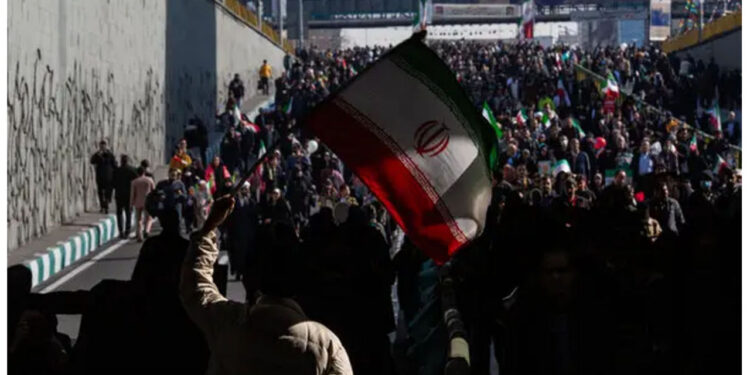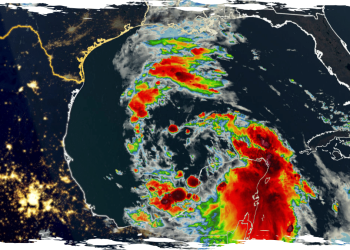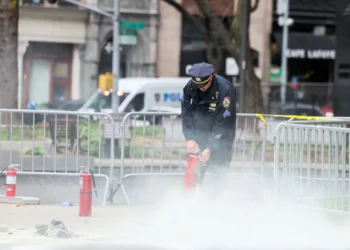In 2015, Iran made a commitment to surrender 97% of its uranium, which could be used for making nuclear weapons. The United States, Europe, Russia, and China collaborated to ensure the success of this agreement.
The Russians even acquired Iran’s nuclear fuel, in exchange for a substantial payment. This development led to optimistic statements, suggesting that Russian President Vladimir Putin could collaborate with the West on crucial security matters and assist in curbing a destabilizing regime in a volatile region.
In the past nine years, significant changes have taken place. China and Russia have shifted their alignment and are now more closely aligned with Iran’s “Axis of Resistance,” which stands against the U.S.-led order. This alignment also includes countries like North Korea. During a recent video call from the White House, President Joe Biden convened leaders from six nations to discuss a shared strategy for de-escalating the Israel-Iran crisis. However, it was evident that no representatives from China or Russia were present on the call.
Vali Nasr, an Iranian-born professor at Johns Hopkins University’s Paul H. Nitze School of Advanced International Studies, warns that the disappearance of a unified front is just one of the many factors contributing to the heightened danger of this moment. In fact, he believes that this may be the most dangerous period in decades.
However, it’s not the only one out there.
When Donald Trump made the decision to withdraw from the nuclear deal established during the Obama era, it was expected that Iran would respond in some way. True to form, Iran resumed enriching uranium after a significant pause. In fact, they have made significant progress and are now much closer to being able to produce a nuclear bomb than they were when the accord was still in effect.
Iran has made significant progress in its ballistic missile program. Just a few months ago, the United Nations restrictions on Iran’s missile development expired. This development is concerning, especially considering the recent missile attacks on Israel. Furthermore, Iran has become a reliable supplier of military drones to Russia and has also enhanced its own drone capabilities by studying Russia’s use of drones during the conflict in Ukraine.
Many Republicans criticized then-President Barack Obama’s pursuit of the 2015 nuclear deal, deeming it dangerously irresponsible. Even some Democrats, who supported the deal’s specifics, expressed concerns about Obama’s optimism regarding its potential to bring about significant change in Iran.
With the recent increase in tensions between Iran and Israel, critics of the Biden administration are now pointing fingers at the lack of a strong stance against Iran in recent years. They argue that this has put Israel at greater risk, especially as it is currently engaged in a conflict with Hamas, an Iranian-backed group, in the Gaza Strip.
“The failure of the White House to acknowledge the current Middle East conflict as an Iranian war against ‘the little Satan’ reflects both a lack of awareness and a display of weakness,” stated John Bolton, former national security adviser to Trump and a staunch critic of the Iran deal.
According to him, it is unfortunate that Israel and the United States have not been successful in deterring Iran. He reiterated his previous stance, along with a few other Iran hawks, that now is the time for Israel to take action and dismantle Iran’s air defenses and potentially target the Quds Force, which is Iran’s most elite unit. In essence, he is suggesting a path of escalation that directly contradicts Biden’s recommendations.
Many experts who are generally supportive of Biden’s diplomacy in the region are expressing concerns about the limited leverage available to influence Iran. This is particularly true if Israeli Prime Minister Benjamin Netanyahu chooses to respond to the attack with a more measured retaliatory strike, as opposed to the approach advocated by Bolton.
According to Nasr, it seems like there is an inevitable clash between Israel and Iran in the future.
According to the expert, the main players in the Middle East are now Iran and Israel. They both perceive each other as significant threats to their national security. What’s concerning is that there are no established boundaries or regulations to keep their rivalry in check. As a result, the ongoing shadow war between them is gradually becoming more overt, and without some form of regulations or guidelines, the situation is likely to escalate further.
When Biden crafted his administration’s strategy, his intention was to create a world where Russia’s disruptions in Ukraine and other areas could be contained, and where there would be strong competition with China. However, this vision was shattered when Hamas executed a terror attack on October 7th, resulting in the deaths of 1,200 Israelis. This event completely disrupted Biden’s priorities and plunged the White House back into a familiar state of chaos.
There is currently no direct communication between the United States and Iran, which marks a significant shift from the past. While President Biden took measures to prevent Iran’s retaliatory strikes from escalating, he relied on intermediaries to maintain indirect lines of communication. This stands in contrast to the previous decade when direct communication between the two countries was more common.
During the Iran negotiations, Secretary of State John Kerry maintained regular and direct communication with Mohammad Javad Zarif, his Iranian counterpart. It is worth noting that Zarif had previously studied in the United States before the Iranian revolution.
During their negotiations on the number of centrifuges Iran could construct, they also successfully resolved potential crises. For instance, when a U.S. naval vessel unintentionally entered Iranian waters and its crew was captured, their phone conversations led to their swift release within hours, effectively preventing another hostage situation.
However, that era has come to an end. With the arrival of the Biden administration, there was an attempt to revive certain aspects of the 2015 deal in the first 18 months. Nevertheless, Ayatollah Ali Khamenei made it clear that there would be no direct talks with the administration. Instead, notes and offers were exchanged through European intermediaries. In the summer of 2022, it appeared that the two sides were on the verge of reaching a deal. However, when the Iranian negotiators brought it back to Tehran, new demands were introduced, leading to the collapse of the entire process.
The fear of a general escalation now has a new, underlying nuclear dimension.
From all the evidence available, it appears that the Iranians have not been hastily pursuing the development of a nuclear bomb. Instead, they have been consistently and methodically advancing their uranium enrichment capabilities. However, as a means of exerting pressure on the West, they have managed to obstruct the inspections conducted by the International Atomic Energy Agency, the global authority responsible for monitoring nuclear activities.
Inspectors have faced restrictions in accessing certain sites, particularly those deemed unfriendly by the Iranians. In some cases, they have been denied entry altogether. Additionally, surveillance cameras have been removed from key locations, making it difficult to monitor activities. Furthermore, there have been instances where inquiries regarding previous activities at military sites have been left unanswered.
Rafael Grossi, the Argentine diplomat and director general of the United Nations agency, expressed his inability to provide guarantees regarding the diversion of nuclear material to other facilities or weapons programs. In an interview conducted prior to the recent missile barrage, he acknowledged the challenges in ensuring the non-diversion of such materials.
Nuclear experts express their major concern regarding Iran’s nuclear program, as they believe that Iran has strong incentives to continue with its nuclear activities. They argue that Iran is driven by the desire to challenge the Western countries and establish its own nuclear deterrence against Israel, which is widely believed to possess undeclared nuclear weapons in the region.
James Clapper, who served as the director of national intelligence under Obama, expressed his concern about the potential acceleration of the mentioned issue.
Experts point out that the effectiveness demonstrated by Israel, with support from the U.S., in intercepting the majority of the drones and ballistic missiles launched by Iran during the recent attack could potentially lead Iranian military officials to reassess their strategies. They might determine that acquiring more advanced weaponry and positioning it in closer proximity to Israeli territory is necessary. This could lead them to consider overtly or covertly pursuing nuclear weapons as their logical next course of action.
Currently, Biden is making every effort to convince Netanyahu, with whom he has a tense relationship, to “accept the victory,” as he expressed to him on Saturday night, and refrain from retaliating.
The Iranians have made it clear that they consider the incident to be resolved. They have sought revenge for the deaths caused by an Israeli strike on seven commanders of Iran’s Revolutionary Guard. However, it is important to note that their definition of “resolved” may only apply to the end of the missile attacks and not necessarily other potential forms of escalation.
Iran’s recognition of the danger and its careful communication of intentions on Saturday have played a significant role in averting a potential conflict. By telegraphing its plans, Iran made it easier for Israel, the U.S., and neighboring Arab forces to intercept the incoming drones and missiles. This action suggests that Iran wanted to make a point without escalating the situation to the brink of war.












